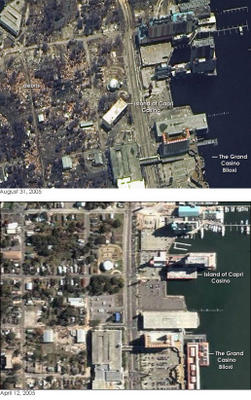New Orleans and Gulf Coast Flooding in the Aftermath of Katrina


Biloxi, Mississippi was one of the communities hardest hit when Hurricane Katrina came ashore on August 29, 2005. Large sections of this seaside city were almost entirely flattened in the storm’s powerful surge. The top QuickBird image, taken on August 31, shows extensive damage in the blocks nearest the shore. Within two city blocks, two floating casinos—the Island of Capri Casino and the Grand Casino Biloxi—have disappeared. The Island of Capri Casino has been carried inland and now sits in the parking lot that was across the street. It is one of the few buildings that retains its structure. All of the houses in the region are gone, replaced by a broad field of debris. In the large image, the Biloxi Ocean Springs Bridge has been washed away, leaving only the pylons that once supported it.
The lower image shows the community on April 12, 2005. The satellite was nearly directly overhead when this image was taken, providing a slightly different perspective than the August 31 image, in which the city is viewed from an angle. The difference is most notable in the high-rise buildings, the sides of which are visible in the top image, but not visible in the lower image. The top image is also slightly rotated in comparison the lower image, so that streets run on an angle instead of perpendicular to the lower edge of the image. Credit: Images copyright Digital Globe .











